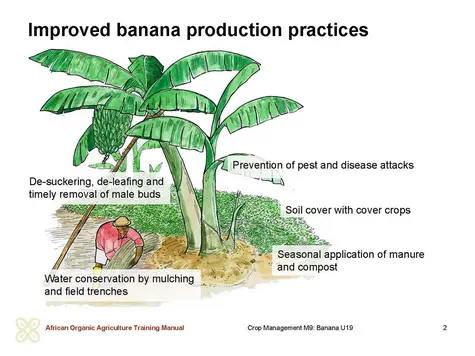Introduction
Banana (Musa species) is a very important crop in sub-Saharan Africa, especially Eastern Africa, where besides consumption as food, bananas have cultural and medicinal values. There are many types of bananas grown in Africa, but depending on how bananas are utilised, they can be broadly grouped as follows:
- Dessert bananas – They include Cavendish, Red Bananas, Apple bananas and Gros Michel. These are consumed as ripe fruits (table bananas). Most cultivars are susceptible to nematodes, Sigatoka leaf spots and Fusarium wilt although they are generally tolerant to weevil attack. Cavendish cultivars are the most popular and valuable of the dessert bananas and are traded worldwide.
- Cooking bananas – They include the East African highland bananas (EAHB) and many other types of plantains consumed as cooked or roasted bananas. The EAHB are said to be endemic to the East African region and grow comfortably at higher altitudes (above 1000 m). On the other hand, most plantains are lowland varieties and are very susceptible to weevil attack.
- Beer bananas – These cultivars can perform well even in suboptimal conditions and are used mostly for production of banana juice which is directly consumed or used for making banana beer, wine or spirits.
- Multipurpose bananas – They include a number of improved cultivars such as the FHIA hybrids. These have multiple uses from being used as dessert bananas to juice production. They are relatively tolerant to nematodes.
Bananas are a perennial tropical and subtropical crop, which grow in a wide range of environments. However, the banana production systems can be divided into three broad categories depending on the number of cultivars grown and the intensity of management.
a. Backyard garden systems
Here banana is grown in a highly integrated system especially in peri-urban areas where land is limited. Bananas are grown mainly for food in combination with other enterprises like zero grazed animals or vegetable gardens to supplement nutritional or peri-urban market needs. This is a low input system and normally no proper pest and disease management is done.
b. Perennial agroforestry systems
In this system, bananas are intercropped with mainly perennial crops like coffee, vanilla, cocoa or fruit trees. In this system, bananas serve as a middle storey shade crop, but also provide food for household needs. Any excess is sold to the market. Different cultivars are normally grown together depending on the location and the intended use of the bananas. The plants are not replaced until they die of senescence or pests and diseases. This is also a low input system and many pests and diseases are either partially controlled or not controlled at all, making banana production highly vulnerable. However, it is the most common production system in most banana producing areas in Africa.
c. Commercial plantations
These are normally ‘single cultivar’ monoculture systems, comprising mostly dessert banana cultivars which have good export potential. Management of these plantations characterised by careful selection of cultivars/varieties and intensive use of synthetic fertilizers and pesticides. In this system, well-defined crop cycles are also observed, usually lasting 2 to 5 years after which all plants are uprooted and replaced.
Challenges to banana production in Africa
Production of bananas in Africa is, however, threatened by many challenges, including:
- Several important pests and diseases – Pests and diseases are the main threat to banana production. Traditional banana cultivars have been severely damaged by a wide range of pests and diseases, resulting in heavy yield losses. For example, bacterial wilt and Fusarium wilt are serious threats in many sub-Saharan African countries leading to 100 % losses. Nematodes, banana weevils, Sigatoka leaf spots and banana bunchy top virus disease have also caused immense damage to plantations. Most farmers lack information on proper management of these infections so they continue to spread them unknowingly.
- Low productivity of banana plantations – Low productivity is mainly due to poor soil fertility management, water conservation and husbandry practices. In highland areas, banana plantations are not terraced and yet many trees are cut out of the garden. Running water from uphill washes down the topsoil and mulch. The soil remains exposed and its water storage capacity is gradually reduced, and yet bananas require good soil moisture for proper growth.
- Many suckers are left per banana stool, pruning and removal of male buds is either done late or not at all. Crop cycles are not regulated whereby the same garden of bananas is left for a long time without rotation or replanting. Suckers for establishing new gardens are carried with all their roots from one village to another, thereby spreading pests and diseases.
- Hailstorm and wind damage – Bananas have shallow spreading roots, weak stems and leaves. This makes them very susceptible to strong winds and hailstorms especially during the fruit bearing stage. This is a common problem in monoculture banana plantations where trees are cut for other purposes and in highland areas.
Bananas, especially the cooking and dessert bananas are widely consumed in Africa and are a source of livelihood for many people. The challenges mentioned above facing banana production need to be addressed to ensure sustainable and profitable banana production and utilization. This chapter therefore introduces organic approaches to banana production challenges, which can be adapted to local conditions.
Discussion: Assessment of the local situation
Inquire about the local practices in banana production and especially about the common challenges faced in banana production asking the farmers the following questions:
- Do you experience any of the above or other challenges?
- How have they tried to address them?


 tap and then scroll down to the Add to Home Screen command.
tap and then scroll down to the Add to Home Screen command.